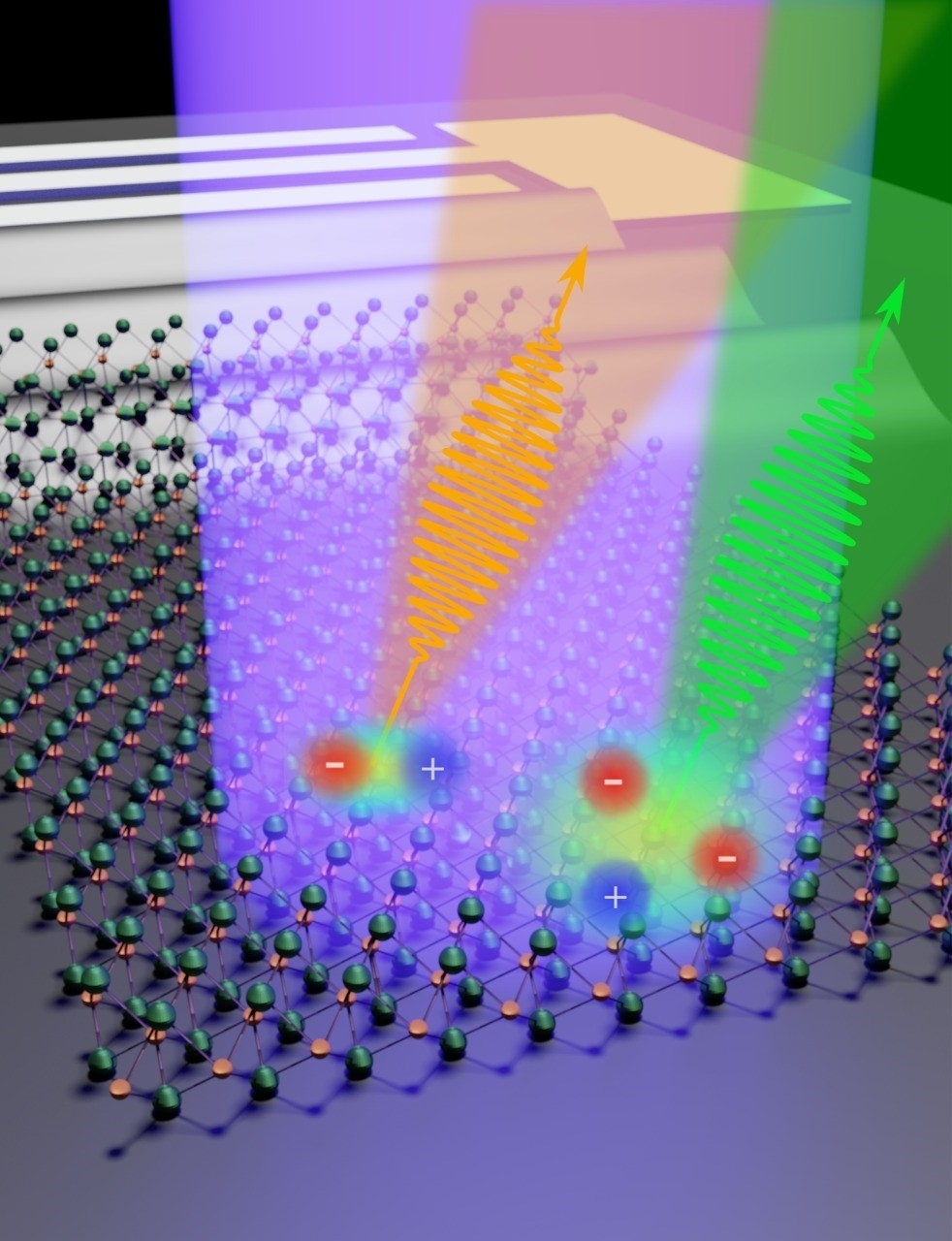


Illustration of the interaction between a surface acoustic wave and neutral excitons (one positive and one negative charge) or trions (two negative charges and one positive charge) in a 2D semiconductor material. The arrows show the direction of the light emitted by the excitonic complexes (image: Diego Scolfaro)
Published on 01/10/2022
By José Tadeu Arantes | Agência FAPESP – Excitons are quasiparticles usually made up of an electron and a hole, meaning the absence of an electron in the structure of the material. The electron and hole interact to form a bound state, as if a hydrogen atom had been artificially created in the material.
An exciton can be produced optically using a laser, and its quantum state can also be read optically by detecting the light it emits when the electron and hole recombine. The photon emitted carries information about the spin and angular momentum of the excitons.
Analogously with electronic circuits, it is possible to imagine exciton-containing circuits in which information is encoded on the quantum state of these quasiparticles and the information is manipulated by applying electrical and magnetic fields.
In a study conducted at the University of Campinas’s Gleb Wataghin Institute of Physics (IFGW-UNICAMP) in the state of São Paulo, Brazil, researchers successfully manipulated excitons using sound waves, as reported in an article published in ACS Nano, a leading journal on nanotechnology.
The study was part of the project “Optical modulation of semiconductor nanostructures using surface acoustic waves”, led by Odilon Couto Júnior, a professor at IFGW and principal investigator for the study. It was the main result of the PhD research of Diego Scolfaro, supervised by Couto Júnior. The article is also signed by Fernando Ikawa, a professor at IFGW, and researchers affiliated with two Brazilian institutions – Federal University of Minas Gerais (UFMG), the Federal University of Ceará (UFC) – and another from Germany, namely Paul Drude Institute for Solid State Electronics (PDI) in Berlin.
The project was funded by FAPESP via a Young Investigator grant, which helped set up an acoustic wave-modulated optical spectroscopy laboratory. The other two co-authors were Matheus Finamor and Luca Trinchão, researchers at IFGW who received scientific initiation scholarships from FAPESP (grants 18/18091-6 and 19/13654-5).
The researchers used a quasi-2D semiconductor material comprising a single layer of atoms of molybdenum diselenide (MoSe2), widely used in experimental research for its strong emissions at room temperature in the band of the electromagnetic spectrum corresponding to visible light.
“One of the reasons for preferring this material is the strong interaction between electrons and holes, which enables it to emit light efficiently at room temperature, unlike other semiconductor nanostructures. On the other hand, precisely because exciton interaction is so strong, efficient manipulation of exciton states becomes quite difficult,” Couto Júnior told Agência FAPESP.
In the study, the researchers used surface acoustic waves (SAWs) to perform a proof-of-concept demonstration that two types of exciton in this class of 2D materials can be manipulated: neutral excitons, each comprising one electron and a hole; and negative trions, each comprising two electrons and a hole.
“SAWs are neither more nor less than mechanical deformations created in a given direction of the material. They carry a piezoelectric field, which can be used to manipulate and modulate exciton interactions so as to control the rate and energy of light emission,” Couto Júnior said.
Piezoelectricity is the capacity some materials have for generating electric voltage in response to mechanical pressure.
“In addition to manipulating exciton emission, SAWs split the excitons and create an on-off system: without them, light emission occurs; with SAWs, emission is aborted,” he explained.
When an exciton is split, he added, the electron and hole are carried by the wave and later recombine. The excitons in the material can be manipulated more predictably by controlling all wave parameters, which is relatively straightforward.
“One of the results we obtained was experimental determination of some parameters that hadn’t yet been reported in the literature, such as the electrical polarizability of excitons and trions in MoSe2 monolayers,” he said.
The article “Acoustically driven Stark effect in transition metal dichalcogenide monolayers” is at: pubs.acs.org/doi/10.1021/acsnano.1c06854#.
Source: https://agencia.fapesp.br/37690